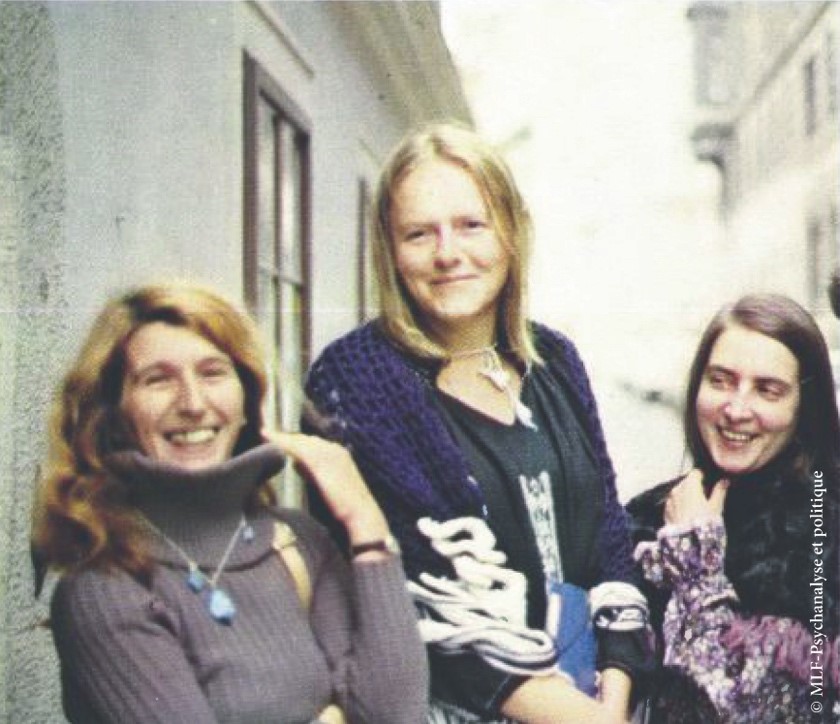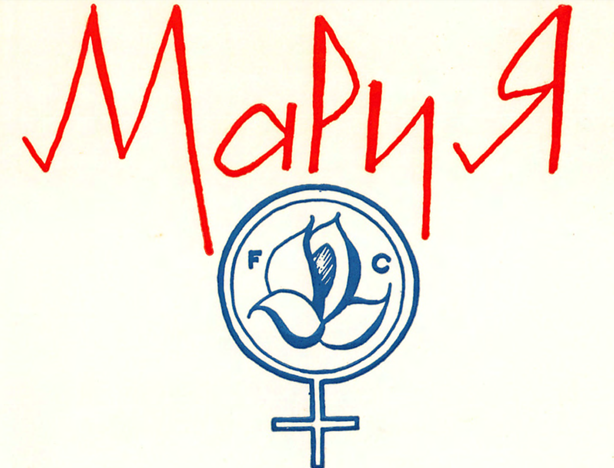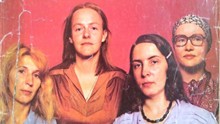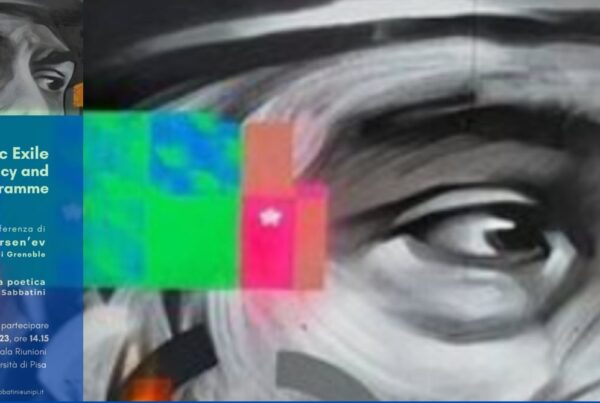
From the left: Iuliia Voznesenskaia, Tat’iana Goricheva, Nataliia Malakhovskaia. Source: Archive of the publishing house Des Femmes – Antoinette Fouque, 1980.
Title of the journal:
Mariia [Mary]
Year of publication: [March] 1980–[February] 1982
Place: Leningrad
Editors: Iuliia Voznesenskaia, Tat’iana Goricheva, Anna-Nataliia Malakhovskaia
Number of issues: 6
Main contributors: Galina Grigor’eva, Nataliia Lazareva, Klavdiia Rotmanova, Tat’iana Beliaeva, Alla Sariban, Sof’ia Sokolova and others
Description:
Clashing visions, and conflicting opinions on “women’s questions” in the USSR led to a split within the editorial staff of the almanac “Zhenshchina i Rossiia”: Tat’iana Mamonova, who first promoted the creation of the almanac, wanted it to keep following a specific editorial line, with an ideology akin to that of western feminism, while the other editors, Goricheva, Voznesenskaia and Malakhovskaia wanted to embrace a more Christian-Orthodox approach. Mamonova was calling for a complete rethinking of social relations but her colleagues considered her radical ideas out of step with the aspirations of many Soviet women. Mamonova saw the Church as a profoundly patriarchal institution and the Soviet system, despite its promises, “had simply become the same old sexist wolf in socialist clothing” (Ruthchild 2017: 103). From this rift a new project was born, named Klub Mariia, a debating club open to all women willing to share ideas and experiences, based on sisterhood, equality and love (cf. Voznesenskaia 1981: 42): “For the first time […] the democratic principles of art have have been adhered to and this experience – the creation of the very first democratic organization – for me is our most important discovery. We have a duty to protect and strengthen what connected and brought us together: to be democratic not in words but in deeds, to uphold love and mutual respect, to be ready to understand one another when we meet difficulties, to blindly believe in our friends’ honest intentions, with confidence and with a willingness to embrace everyone’s concerns and remarks, as long as they are relevant to the common cause” (Voznesenskaia 1981: 18).
The club’s foundation was followed by a samizdat journal of the same name, independent from the almanac, but published alongside it. The first meeting took place on March 1st , 1980 and on that very day the draft of the first edition of “Mariia”’s was seized. It was entirely rewritten in May of the same year; the first section entitled Nashi vzgliady, idei, pozitsii (Our opinions, ideas, points of view) included the shorthand text of a debate on feminism and marxism, openly stating, through a clear reference to the Virgin Mary of the journal’s name, the philosophical-religious and anti-marxist leanings of the project (cf. Voznesenskaia 1981: 43). The aim of the magazine was to develop an alternative and uniquely Russian approach to feminism: marxism, radically based on materialism and economic transformation of the state, did not consider the impact it had on people’s and especially on women’s everyday lives, and there was thus an enormous contrast between the ideal and the real (cf. Zorya 2020: 152). Thanks to the participation of the intelligentsia in philosophic-religious seminars and the circulation of forbidden materials through the Union of Evangelical Churches of Baptist Christians, the USSR’s cultural underground came increasingly into contact with religious thinkers, and taking inspiration from the journal “Obshchina” (cf. Dolinin-Ivanov 2003: 94; Voznesenskaia 1981: 42), the editors of “Mariia” turned to religion and the Church to regain a sense of humanity, spirituality and hope.
“Man was created in God’s image and likeness. These very words may surprise us. The tyrants of the 20th century, in considering people as indistinct mass of individuals to the extent that they could pretend not to see them, made us accustomed to the horrific devaluation of man’s subjectivity. A fragile being, a creature able to crumble into a handful of ashes before your eyes, that is what man is, what each of us is for our contemporary consciousness. All those impressive social experiments, that have instilled hope in previous generations, led us to this tragic conclusion. In these desperate times, when hopes for the reconstruction of a just society are dying one by one , […] sometimes it seems as if there is nothing left to hope for. But it is exactly in our own times that hope reawakens, because, paradoxically, as the well-established stereotypes of a socially closed consciousness explode, hope reignites […]” (Malakhovskaia 1982: 73-74).
Although none of the members of the Soviet women’s liberation movement, except for Goricheva, ever came to hold extreme positions of faith, it is clear that all of them needed to recover the differences between men and women in order to enhance the qualities of both: it was only through searching for and rediscovering the “feminine” in women – which was understood as romance and attraction – and “defeminizing” men, that human beings would find salvation, freedom, purification and a consequent spiritual rebirth. In a state without God, whose theoretical insistence on equality between the sexes had produced hermaphroditic beings, these women found refuge in the Church: “in Christianity the deification of man has been and is still possible” (Goricheva 2020: 133). In the text entitled Raduisia, slez Evinykh izbavlenie (Hail, thou who hast redeemed Eve’s tears), already published in the almanac “Zhenshchina i Rossiia” (1979), Goricheva states: “In a society where all that is sacred is trampled upon and defiled, man’s strengths and capacities are misdirected, human nature itself is distorted. The crude materialism of the dominant values gives birth to a one-dimensional being, without qualities and without sex, the ‘homo sovieticus'” (ibid.: 136).
Unlike the almanac, “Mariia” was characterised by a well-defined internal structure with different sections, including Nashi vzgliady, idei, pozitsii (Our Opinions, Ideas, Points of view), Zhenshchina i Tserkov’ (Women and the Church), Nasha schastlivaia, schastlivaia, schastlivaia zhizn’ (Our Happy, Happy, Happy Life), Zhenshchina i GULag (Women and the GULag), Zhenshchina i sem’ia (Women and the Family), Pis’ma po molitvam bogomateri (Letters of Prayer to the Mother of God), Poėziia i proza (Poetry and Prose), which served to highlight the heterogeneous character of a magazine which, nevertheless, aimed to preserve a degree of continuity with the almanac in publishing articles of social criticism with a clear political orientation. In addition to focusing on issues such as clandestine abortion, domestic violence, psychological violence in the workplace and the environment of the “second culture”, the editors also chose to address moral and religious issues, such as chastity and sacrifice, humiliation, humility and obedience. Ekaterina Kazanskaia commented: “Humility is often the result of fear. The fragile person is afraid of the consequences of his words, of his actions, he fears the day of reckoning. To preserve a grain of self-esteem, he passes off as humility his refusal to act and to manifest his thoughts, that is, his weakness. Obedience to Christ, humility towards Him, must not turn into humility towards man, worship of the Lord God of Heaven must not take the form of worship of the rulers of the Earth, of the powerful men of this world, although humility towards them helps to overcome fear. […] The worshipper cannot and must not be a humble-fearful person. Orthodoxy condemns fear before God because, like fear in general, it always prevails over love for God and the desire to draw near to him. Humility is a man’s estrangement from God, from his own noble purpose and from people” (Kazanskaia 1982: 18).
The KGB’s response to magazine was immediate. There were searches, interrogations and arrests, followed by the exile of the editors Goricheva, Malakhovskaia and Mamonova on the eve of the Olympic Games in July 1980. In the West, in Vienna, they were welcomed by their colleague Voznesenskaia, who, the previous May, had already been forced to emigrate, and by many journalists who immediately showed interest in their personal experiences and activism. That same month, the second issue of the magazine came out, which contained a special section entirely dedicated to the Soviet invasion of Afghanistan, which had already begun in December 1979: the first article, entitled Klub Mariia protiv okkupatsii Afganistana (Klub Mariia against the occupation of the Afghanistan) declared a united anti-militarist stance on behalf of the entire women’s movement which denounced a military operation that had been publicized as an “act of liberation”, especially for Afghan women. In the article Bratskaia pomoshch’ (Fraternal help), written by an Afghan man, appeared the words:
“I listened to women’s speeches in the crowd:
Why do they send their sons to kill our boys and our women?
Don’t they know that their children will only come back to them in coffins?
They will shed tears! Why did they not cry when they sent them here?
To one of those women, I said:
‘It’s terrible to be a mother in the Soviet Union: they don’t even know where they are sending their children, and what’s more, they won’t know where their graves will be or in which field they will be buried'” (Anonymous 1982: 15-16).
On March 1st, 1980, during the first meeting of the club, the first document addressed to the public, Obrashchenie k materiam (Plea to mothers), was drawn up, revealing the deceptive nature of war propaganda and affirming that mothers of soldiers preferred prison to death for their sons.
The exile of its editors did not put an end to the magazine: the fourth and fifth issues were published in 1981, under the editorship of Klavdiia Rotmanova and Tat’iana Beliaeva, and after they were also exiled, Elena Shanygina, Sof’ia Sokolova and Alla Sariban took over. On the 24th of September 1981, after her studio was searched, the artist Natal’ia Lazareva was arrested for having written, the previous year, an anti-war appeal addressed to all the women of the world, which had never been published on the magazine. Once released from prison, Lazareva began preparing the sixth issue, but one of the three copies in her possession was immediately seized by the KGB. This was the reason for her re-arrest and a further four-year prison sentence (cf. Lazareva 1998: 69-70). Increasingly harsh repressions followed to the extent that all the members of the movement were finally silenced. Malakhovskaia, Goricheva and Voznesenskaia managed to get the first three issues of the magazine published in Tamizdat and made great efforts to have their colleague’s sentence turned into an exile: in the second tamizdat issue of “Mariia”, in fact, an appeal addressed to the whole world was published – signed by Voznesenskaia and Grigor’eva – in which they asked for help for their friend. There was an outpouring of international solidarity, especially from French feminists, who organized a committee and economic fund to support Leningrad’s feminists. In 1981, a branch of the club was founded in Germany through the German Society for the Defense of Human Rights, with the aim of providing aid to the women’s movement in Russia and promoting the exchange of information (cf. Voznesenskaia 1981: 43). Lazareva, however, was not released and the magazine ceased to exist.
In 1980 the first issue of “Mariia” was published in French, and in 1983 a collection of articles extrapolated from the first three issues was published in Italian with the title L’altro femminismo (The other feminism), printed by the publishing cooperative La Casa di Matriona.
The philosophy of by the magazine can be traced in the later writing of Tat’iana Goricheva, in which she states that: “Society has moved closer to Christian truth” but that woman should beware of “a new slavery […]: instead of ‘patriarchal’ subordination and ideas, feminist ideologies have come to us. Feminism ‘functions’ only on the surface: it remains a materialist movement, [and remains] ‘all too human’” (Goricheva 1992: 5).
Ultimately, this Russian women’s movement, deeply bound with spirituality, did not find a resonance in the real world; on the contrary, it was difficult to understand for the Leningrad underground and (mainly left-wing) Western feminist movements that both tended towards secularism and anticlericalism.
Giulia Pertosa
[31st December 2022]
Bibliography
- AA. VV., “Mariia” № 1, Leningrad-Frankfurt-na-Maine, samizdat 1981.
- AA. VV., “Mariia” № 2, Leningrad-Frankfurt-na-Maine, samizdat 1982.
- AA. VV., “Mariia” № 3, Leningrad-Parizh, samizdat 1983.
- AA. VV., Tat’jana Goričeva e il Club “Maria”. L’altro femminismo, ed. by Centro studi “Russia cristiana” , intr. by O. Clément, La casa di Matriona, Milano 1983.
- Anonymous, Bratskaia pomoshch’, “Mariia”, 2 (1982): 13-19.
- De Feo M., «Donne e Russia», un nuovo “dissenso” da scoprire, “Effe”, marzo (1980), https://efferivistafemminista.it/2014/11/un-nuovo-dissenso-da-scoprire/, online (last accessed: 31/12/2022).
- Dolinin V., Ivanov B. (eds.), Samizdat (Po materialam konferentsii «30 let nezavisimoi pechati. 1950-80 gody». Sankt-Peterburg 25-27 aprelia 1992 g.), Novoe Literaturnoe Obozrenie, Moskva 2003: 3-21, 94-99.
- Goricheva T., Docheri Iova. Khristianstvo i feminizm, Alga-Fond, Stupeni, Sankt-Peterburg 1992.
- Goricheva T., Raduisia, slez Evinykh izbavlenie, in O. Vasiakina, D. Kozlov, S. Talaver (sost.), Feministskii samizdat. 40 let spustia, Common place, Moskva 2020.
- Kazanskaia E., Ia ne khvalius’ smirennost’iu moiu, “Mariia”, 3 (1982): 17-20.
- Lazareva N., Po ėtomu delu v tIurmu sela ia odna, “Pchela”, 12 (1998): 68-71.
- Malakhovskaia N., Chelovek-nadezhda, “Mariia”, 3 (1982): 73-81.
- Ruthchild R., Feminist Dissidents in the “Motherland of Women’s Liberation”: Shattering Soviet Myths and Memory, in B. Molony, J. Nelson, Women’s activism and second wave Feminism, Bloomsbury Academic, London 2017: 99-120.
- Sidorevich A., Sotsial’naia revoliutsia ne osvobodit zhenshchinu, esli ona ne budet revoliutsiei dukhovnoi, “Ostrova ne Svoboda”, https://spb.iofe.center/node/237?fbclid=IwAR25czfJPMeGiRbT8ulE4qZmaWw2IdGmyqmZyQG15YdpTiOicSRYtZX7NQQ, online (last accessed: 31/12/2022).
- Voznesenskaia Iu., Domashnii kontslager, “Mariia”, 1 (1981): 13-19.
- Voznesenskaia Iu., Zhenskoe dvizhenie v Rossii, “Posëv”, 4 (1981): 41-44.
- Zorya K., The Maria Underground Zine: Religious Feminism in 1980s Leningrad, in S. Sorgenfrei, D. Thurfjell, Kvinnligt religiöst ledarskap: En vänbok till Gunilla Gunner, Södertörns högskola, Huddinge 2020: 149-160.
To site this article:
Giulia Pertosa, Mariia, in Voci libere in URSS. Letteratura, pensiero, arti indipendenti in Unione Sovietica e gli echi in Occidente (1953-1991), a cura di C. Pieralli, M. Sabbatini, Firenze University Press, Firenze 2021-, <vocilibereurss.fupress.net>.
eISBN 978-88-5518-463-2
© 2021 Author(s)
Content license: CC BY 4.0





